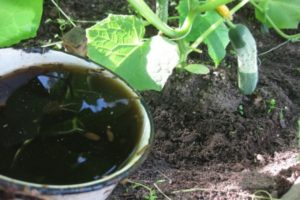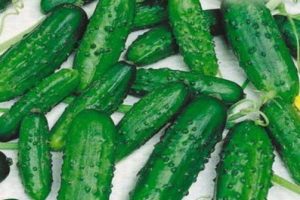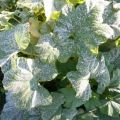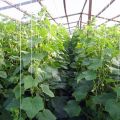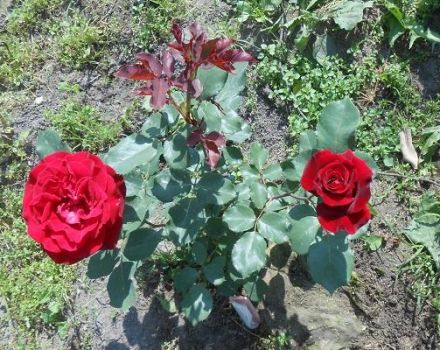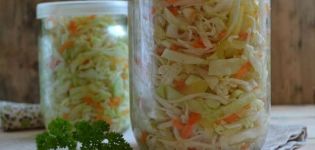How to deal with diseases of cucumbers in the open field and in a greenhouse, how to protect and how to spray
Quite often, gardeners have to deal with diseases of cucumbers, which can lead to the death of plants. In such cases, it is necessary to understand how to treat the disease. For this, special drugs are used for treatment and cucumbers are treated for diseases.
Causes of diseases
Before you protect cucumbers from diseases, you need to familiarize yourself with the causes of their occurrence. There are several specific reasons why young plants get sick.
Unsuitable temperature
Often, fungal diseases of cucumbers occur due to non-observance of the temperature regime during cultivation. The cucumber is a thermophilic plant that does not tolerate sharp temperature changes. If the temperature is too low, the cucumber bushes will grow more slowly and all their nutrients will be used up to support the most important life processes.
At temperatures below ten degrees Celsius, the likelihood of cucumber disease increases several times.
The increased temperature also negatively affects the health of the bushes. If it is above 30 degrees, then the accumulation of substances for growth will stop. The plant will become susceptible to most infections and the cucumbers will have to be treated for disease.
When growing bushes, it is recommended to maintain the temperature within 20-25 degrees Celsius.

Soil moisture
Cucumbers in the garden often get sick due to the low level of soil moisture. Low humidity impairs the supply of nutrients as they cannot dissolve.
Also, bacterial and infectious diseases can appear as a result of high soil moisture. A large amount of liquid displaces air from the ground, which causes oxygen starvation at the roots. If this problem is not resolved in a timely manner, then the plant can not only get sick, but also die.
It is recommended to periodically monitor the moisture content of the soil with cucumbers. To do this, you can use a special moisture meter. The optimum humidity level should be 70-80%.
Air humidity
In order not to think about how to save cucumbers from diseases in the future, you need to monitor the humidity in the room with the plants. It should be within 80-90%. A hygrometer is used to check this indicator.
When humidity is less than 55-60%, cucumber leaves begin to evaporate more moisture, which leads to serious energy consumption. This leads to a slowdown in growth and a weakening of the immunity of the bushes.
If the humidity is more than 95%, then this can also negatively affect the cucumbers. Because of this, the leaves of cucumbers become covered with drip dew, which often leads to the occurrence of diseases.
Improper nutrition
Quite often, disease prevention and protection from pests is accompanied by fertilizing the plant, which should make it stronger and more resistant to disease. To do this, several times per season, fertilizing is introduced into the soil, consisting of nitrogen, potassium and phosphorus. If there is too much nitrogen in the fertilizer, the likelihood of infection of the bushes will increase.
Genetic resistance
Some varieties of cucumber do not have genes to protect them from disease. That is why it is recommended to plant only those varieties that are genetically resistant to the most dangerous diseases.
Sources of infections
Most cucumber diseases appear when there is a source of infection. These include:
- Last year's plant remains. It is recommended to regularly clean the area of residues, since they are the most common source of the spread of diseases.
- Weeds. Quite often, they are carriers of infections, so weeds should be disposed of before planting cucumbers.
- Seed infections. Before disembarking, disinfection must be carried out for prophylaxis.
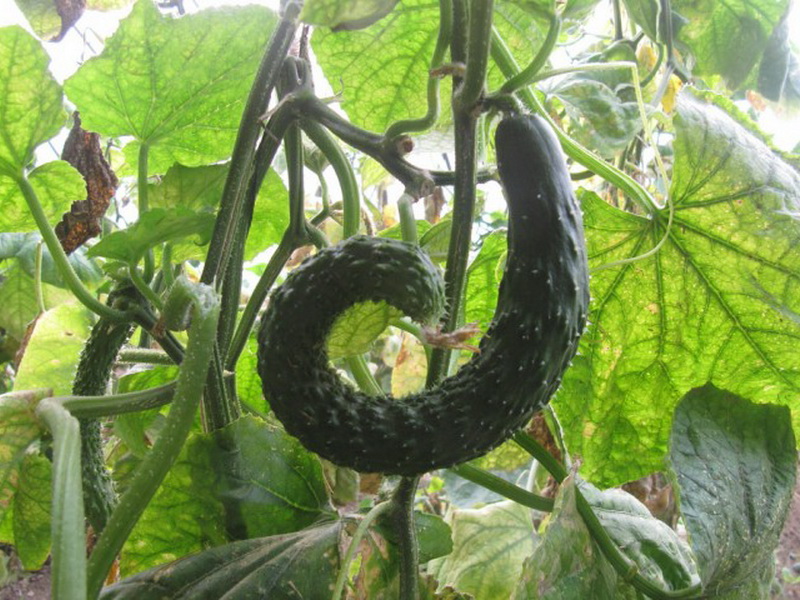
Powdery mildew
Such a disease of cucumbers as powdery mildew is very common. Before treating her, you need to study her photo and description.
Signs
During the appearance of the disease, curly leaves are observed. Over time, many specks of gray appear on them. Gray spots on the leaves of cucumbers gradually spread over the leaves and completely cover their surface. Because of this, they begin to turn yellow and fall off. It is recommended that you familiarize yourself with the features of the manifestation of powdery mildew in the picture in order to better understand how it looks.
The reasons
There are several reasons why the leaves are covered with a grayish coating. Shrubs suffer from powdery mildew, which are rarely watered and overfeed with fertilizers with nitrogen. However, the main reason is the low temperature in greenhouses and outdoors. Powdery mildew most often develops at temperatures below 10-15 degrees. If this indicator is more than 25 degrees, then the spores will stop spreading and begin to die.
Treatment with folk remedies
Many vegetable growers do not know how to process cucumbers during the treatment of such a serious disease. There are quite effective folk methods of struggle.
For treatment, it is recommended to spray the bushes with mullein infusion. It is prepared from three liters of water and 1 kg of mullein. For processing, only the infused solution is used, which must be infused for two or three days. After that, the mullein mixture must be filtered and again poured with three liters of purified water.
Also, untreated bushes can be sprinkled with a mixture made from sour milk. To prepare it, milk is mixed with warm water in equal proportions. The tool is applied no more than once a week.
Manganese solution, which is very easy to prepare, will help get rid of this disease. To do this, two grams of potassium permanganate are added to ten liters of water. Then the mixture is infused for 1-2 hours and applied to the bushes.
Use of chemicals
Special chemicals are often used to process cucumbers. The most popular is Fitosporin, which is recommended for use after the first signs of powdery mildew appear.

In case of serious damage, fungicides and preparations with copper are used. Colloidal sulfur is also used instead of these agents.
Preventive measures
To prevent the bushes from becoming infected with powdery mildew, it is necessary to engage in the prevention of cucumber diseases in the open field. Preventive measures include the following:
- regular watering of the bushes with heated and settled water;
- maintaining cleanliness in the beds and in the greenhouse - timely cleaning of dried plant residues and weeds, loosening the soil;
- maintenance of optimal temperature conditions;
- cultivation of disease-resistant cucumber varieties.
Peronosporosis
The disease affects bushes in open ground and in greenhouses. To understand how to protect cucumbers from diseases and peronosporosis, you need to familiarize yourself in more detail with the description of the disease.
Signs
After infection, the green leaves on the bushes are repainted in a light yellow color. Over the course of several weeks, they begin to darken and gradually fade. If you do not spray the cucumbers with special preparations in a timely manner, they will die.
The reasons
The main causative agent of this disease is a fungus. The optimal conditions for its appearance and development are high humidity and low temperature. Therefore, in a well-protected and insulated greenhouse, peronosporosis appears much less often.
Traditional methods of treatment
You can treat cucumbers using some folk methods. Quite often, a special milk whey is used for this. To prepare it, a liter of milk is mixed with a liter of warm water. Also, this solution can be used for prevention. Some gardeners use a mixture made from iodine and kefir. During its creation, it is necessary to add four drops of iodine to five liters of kefir.
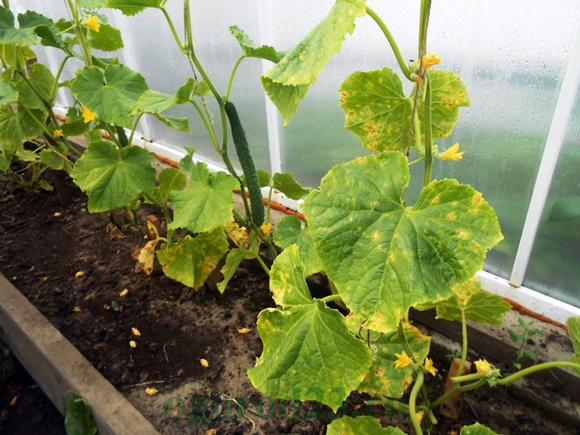
Chemicals
Sometimes traditional methods do not help cure peronosporosis and gardeners do not know what to do next. In such cases, it is recommended to use chemicals, as they are more effective in treating diseases.
Most fungi are known to be incompatible with copper. That is why you should use Bordeaux liquid. It is prepared from one hundred grams of copper sulfate, lime and several buckets of water. You can also make a copper / soap mixture. For this, 200 grams of soap and 20 grams of copper sulfate are added to a bucket of water.
Keep in mind that chemical mixtures can only be used at temperatures over 25 degrees.
Prevention
Preventive measures are pretty simple:
- collect the ripe crop in a timely manner;
- do not plant cucumbers too close;
- water the bushes only with heated water;
- burn the remnants of old bushes, which may contain spores.
Chlorosis
Chlorosis, like bacteriosis of cucumbers, is a fairly common disease in cucumbers and other plants. It appears due to a lack of chlorophyll involved in photosynthesis. As a result, yellow and dry spots appear on the leaves.
Signs
A diseased bush may show various signs, which depend on what kind of substance the plant lacks.
With a lack of iron, the spotted leaves begin to turn yellow or turn white. However, their veins retain their original green color. At first, signs begin to appear on the leaves located on top. Over time, they spread to the lower ones.
If there is not enough nitrogen for the bushes, then chlorosis will manifest itself differently. In this case, the veins begin to change color, which immediately turn white. Gradually, the disease completely destroys the leaves.
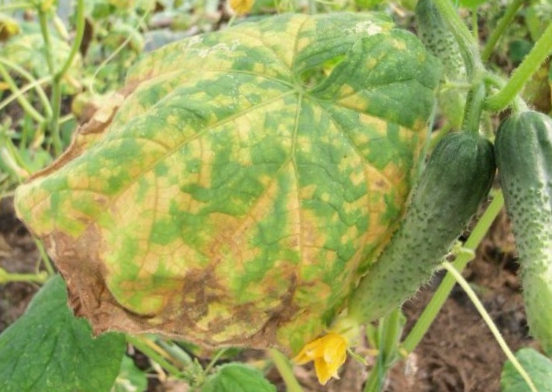
The reasons
There are various reasons why chlorosis occurs in cucumbers. These include:
- Lack of minerals and trace elements.It is because of this that mottling appears most often on the leaves.
- Infections. Chlorosis can appear after contracting an infection. Quite often, infectious diseases are carried by insects that fly from infected bushes to healthy ones. Therefore, it is recommended to get rid of diseases and pests in a timely manner so that chlorosis does not appear.
- Improper planting and poor growing conditions. The disease can appear if the roots of the plant were damaged during planting. It also appears in the absence of drainage.
Treatment
It is imperative to treat chlorosis, since without this, the bushes may die. Iron chelate is used to treat bushes with iron chlorosis. It can be prepared by adding several grams of citric acid and ferrous sulfate to a liter of water. The result should be a mixture with a yellowish tint.
Some growers fight the disease with rusty nails. They are placed in the soil near infected bushes. You can also put cleaned off rust into the ground. This method is recommended if other methods have not helped in the treatment of chlorosis.
Ascochitosis
Cucumber ascochitis is most often found in greenhouses. In plants that are grown outdoors, the disease appears much less frequently.
Signs
First, oval dark dots of a grayish tint appear on the sheets. Over time, they turn brown and gradually dry out. They also sometimes experience minor burns. The disease spreads very quickly throughout the bush. At the same time, ascochitis rarely damages the vascular system, which allows infected plants to bear fruit. In the later stages of development, a black bloom appears on the cucumber leaves on the stems.
Ascochitosis also appears on the fruits of the plant. First, the fabric on top of the cucumbers begins to dry out. In just a few days, the fruit will completely turn black and rot.

The reasons
Most often, the weakest bushes suffer from ascochitis. Plants that are poorly cared for are susceptible to disease. Also at risk are bushes that are too densely planted.
Treatment
Before spraying cucumbers, you need to understand the features of the treatment. First, you need to treat the greenhouse to stop the spread of the disease and destroy sources of infection. For this, a weak formalin solution is used. One square meter of the greenhouse should be sprayed with a liter of the prepared mixture.
During the treatment of the disease, a pre-prepared Bordeaux mixture is used. Also, diseased bushes can be sprayed with urea mixed with copper sulfate. It is necessary to use these funds for a week.
Some vegetable growers use special preparations. For example, you can use the Saprol remedy, which helps to cope with most cucumber diseases.
Alternaria
Alternaria appears in almost all varieties of cucumbers. This disease negatively affects the productivity of plants. It can drop several times.
Signs
Appears in bushes that grow in the greenhouse and are located closest to the others to its doors. At the initial stage of development, the leaves are covered with small convex specks, the size of which does not exceed a centimeter. The mottling first appears at the edges of the leaves and eventually spreads to the rest of them. If you ignore the disease and do not deal with it, then the leaves will begin to fall off.
The reasons
Alternaria appears in conditions of high temperature and high humidity. That is why it is recommended to monitor the climate in the greenhouse where the cucumbers are grown.
Treatment
If the bushes are already sick and the first symptoms of the disease have appeared, you must immediately lower the temperature in the greenhouse to 20 degrees.To do this, films are removed from the beds and the doors are opened for ventilation. After that, cucumbers should be treated with copper products. To do this, you can use Bordeaux liquid or Fitosporin.
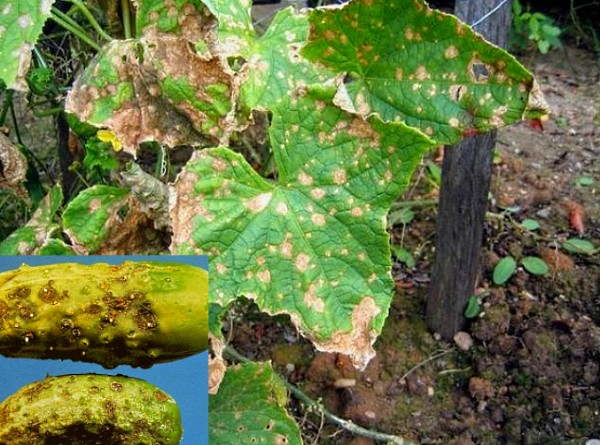
Root rot
Root rot is one of the most dangerous and common diseases.
Signs
The disease appears at all stages of the development of cucumber bushes. It is very difficult to determine it, since the spread of rot begins from the root system. The first symptoms are darkening and wilting of the roots. Gradually, the disease spreads to the stem. If measures are not taken in time, the infected bush will die.
The reasons
The main reason for the appearance of root rot is inappropriate conditions for growing and fruiting bushes. The disease develops rapidly in high temperature conditions. It can also appear if supercooled water is used for irrigation.
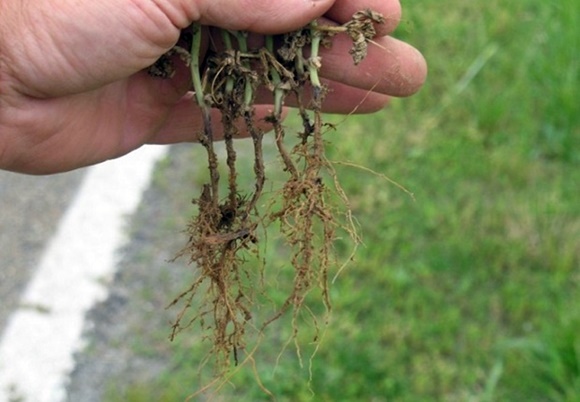
Treatment
Immediately after obvious manifestations of the disease, the root system should be restored. To do this, it is necessary to scatter a thin layer of fertile soil around each infected bush. With its help, new roots will be formed. This procedure should be accompanied by regular watering with warm water.
Sometimes it is not possible to detect the disease in time. In such situations, it is almost impossible to save the plant and you will have to get rid of it. If the bush has already dried up, then it will have to be dug up and burned so that the disease does not spread to other bushes.
Conclusion
It is quite simple to identify diseases of cucumbers in the open field and fight them. For this, it is recommended to study the diseases of cucumbers and their treatment. You also need to familiarize yourself with their prevention in advance. Having familiarized yourself with all this, you will protect the grown bushes.
